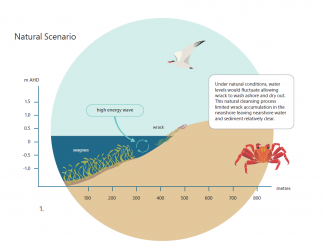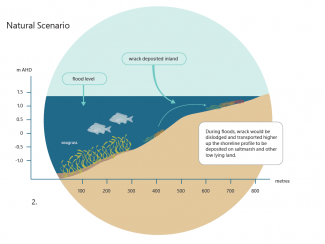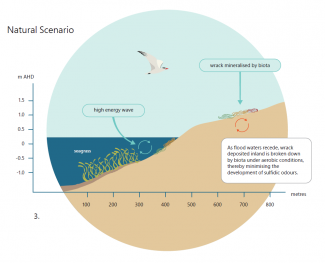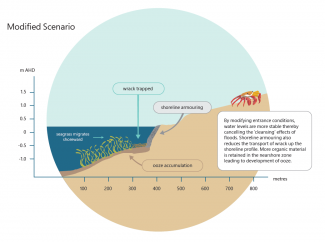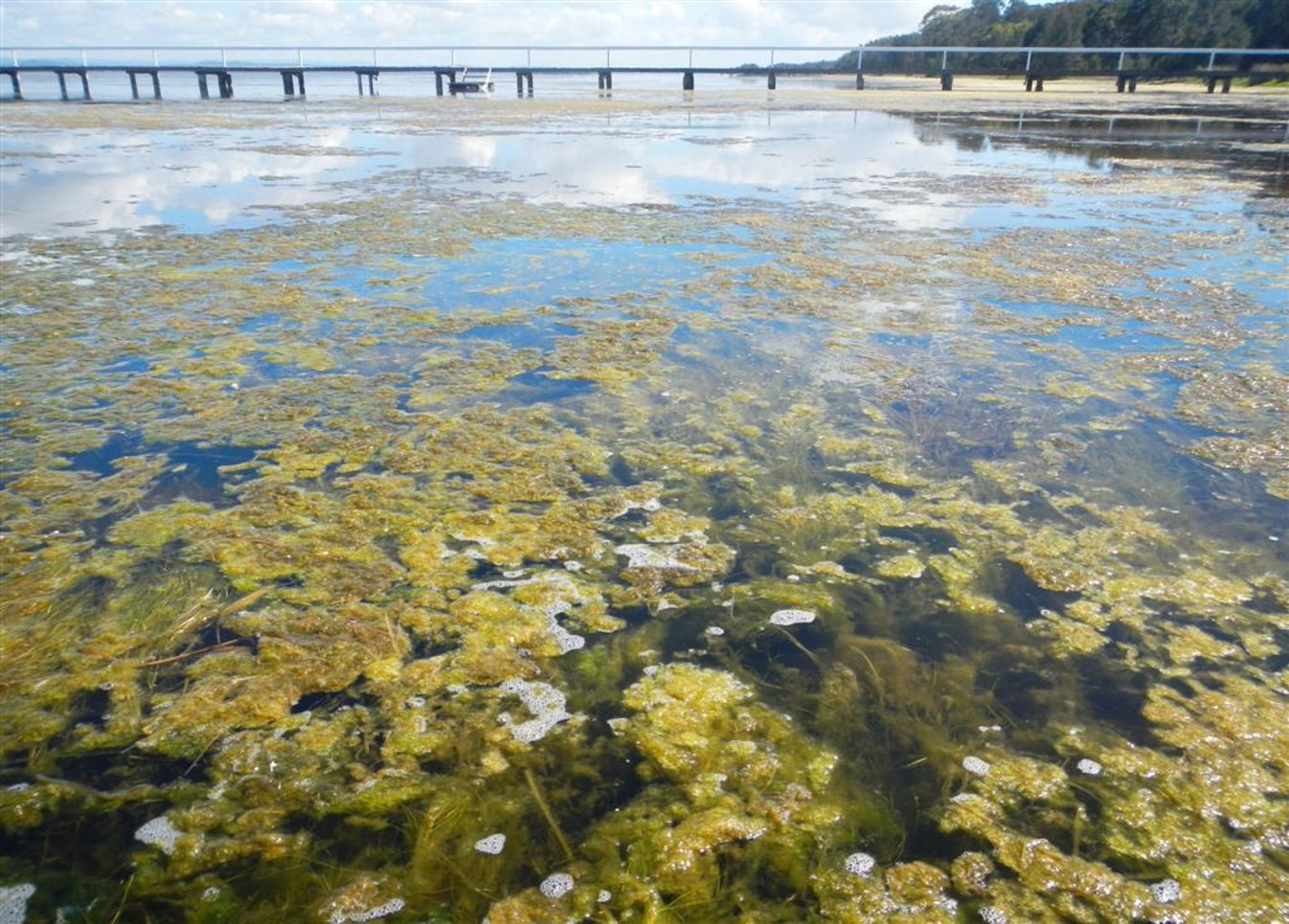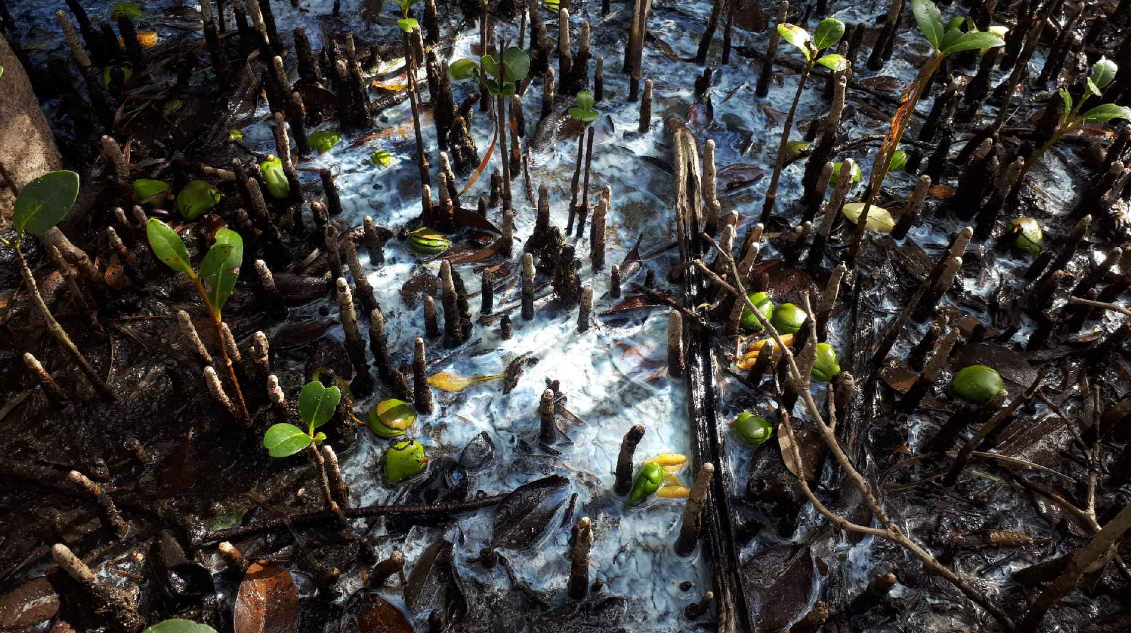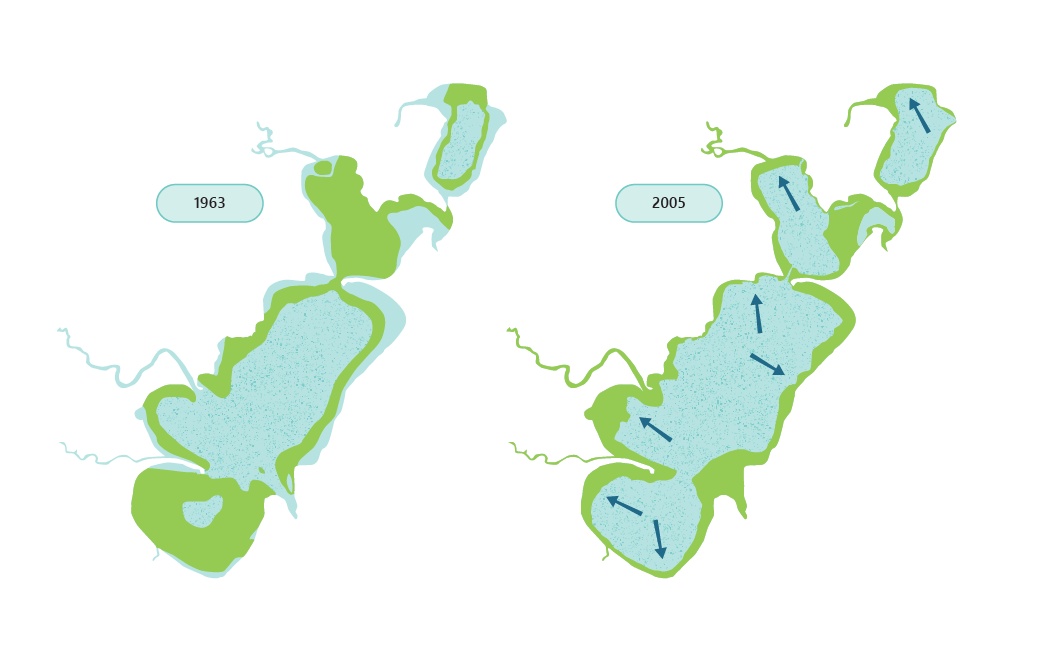Seagrasses and macroalgae play a crucial role in the health of the estuary. They use nutrients and stabilise sediments that have been washed into the system, and together provide habitat, nourishment, nutrient-cycling and carbon storage for the whole estuarine ecosystem.
Seagrasses are the only flowering plants that can live underwater. They naturally shed their leaves, allowing the dead leaf matter to wash onto the foreshore. When their leaves decompose, they support the plants that constitute saltmarsh, such as intertidal sedges, rushes, reeds, grasses, succulent herbs and low shrubs. Seagrass can often also be dislodged by boats, fishing nets or bottom-feeding birds. Once the leaves start to float, they form rafts blowing towards the shore. At times, floating macroalgae can also bloom and move around the estuary.
The leaves shed by the seagrasses are called wrack. Wrack is a natural part of the estuary, notable as a source of food and habitat for the local flora and fauna. It also serves as a vital segment of the energy cycle. It has always been prevalent in the waters of the Central Coast, with historical records and hand-drawn maps of wrack accumulation dating back to the early 1900s.
There are two possible fates for wrack. Washed up by the wind waves, it either finds its way onto the shore and settles on the shoreline above water level, landing on saltmarsh if there is a gradual slope. Alternatively, if it meets a steep or modified edge, wrack gets stuck in the water to rot.
More info
Saltmarsh
Before European settlement, saltmarsh was a popular feature within the Tuggerah Lakes estuary. This vegetation community has always supported the natural processes at the water’s edge. Where saltmarsh plants are present, wrack will wash ashore and dry out, decompose and become part of the foreshore soils, creating a healthy habitat for invertebrates and wading birds.
Modified Edges
In areas with a modified shoreline and steeper banks or where the saltmarsh has been mown over, wrack sits in the water and begins to break down.
Circulation
Where wrack blocks the nearshore zone, the water quality can be affected. Council has a research-backed seasonal wrack collection program that prescribes which shorelines should be cleared in different parts of the year. It also helps to take advantage of wind direction, which improves the mixing and flushing of nearshore areas.
The nearshore water quality can be enhanced by:
- Reducing incoming pollution;
- Regrading foreshores and reinstating natural slopes, ideally with saltmarsh for biodiversity;
- Reintroducing natural water level fluctuations;
- Collecting wrack at appropriate times to enhance wind mixing.
Macroalgal Blooms
Macroalgae is a collective term used for seaweeds and marine algae that are a natural part of the lakes' ecology, and one of the primary sources of food for aquatic animals. Some are attached to the bottom of the lake, while others are free-floating.
Macroalgae needs light, food – that is, nutrients – and the right temperature to grow. If the lake meets these conditions, macroalgae can grow rapidly and bloom. Macroalgae blooms are a natural part of an estuarine life and occur even in the most pristine waters. However, persistent blooms can be a sign of the ecosystem’s decline. Excessive growth of the epiphytic type of algae, a kind that emerges on seagrass and other aquatic structures, can affect the long-term health of the lakes.
Further complications occur when algal blooms die off. Rapid decomposition can reduce oxygen levels in the water, negatively affecting nearby plants and animals.
Bacterial Blooms
Bacterial bloom, sometimes called a blossom, is a condition that occurs when the number of bacterial colonies in the water suddenly increases. In estuaries, sulphate-reducing bacteria appear periodically, presenting as a white slick or milky film floating on the water surface. Bacteria bloom is common in slow-flowing drainage lines and shallow, quiescent areas amongst mangroves and seagrasses.
Sulphate-reducing bacteria are anaerobic species, which grow under very low-oxygen conditions. Like other bacteria, they respond to favourable environment by blooming, and then die off again when conditions change. Alternatively, their blooms are dissipated and diluted by a change in flow patterns.
Low levels of dissolved oxygen occur when the water is stagnant due to pooling or low flow, or when there are high levels of organic material consuming oxygen as they decompose. Insufficient amounts of dissolved oxygen can be dangerous to fish and other aquatic life.
Bacterial blooms often raise concerns and are reported as chemical or paint spills, but they are not harmful to the surrounding environment, and they dissipate in time. Special tests are available to confirm the presence of bacteria in the waters.
Some examples of bacterial overgrowth are shown below:
Brown and Murky?
Tuggerah Lakes can look dirtier than the other estuaries. Why? Firstly, because its waters are shallow. Secondly, the seagrass covering the lakes' bed seems to have shifted away from the middle and moved towards the edges.
Seagrass is a plant, and plants need light to grow. As the amount of dirt coming from the catchment increased over time, the waters got cloudier. As a result, in their search for light, seagrasses migrated into the shallower waters, leaving behind the muddy bed. Then, wind waves stirred up the bed sediment, which made the lake look grimy. As the seagrass moved towards the lakes' edges, the sandy shores that people used to cherish were partially lost. This process, called 'a negative feedback loop', can be very difficult to reverse.
Now, the seagrass forms a barrier between the nearshore zone and the middle basins, trapping pollution around the lake's edge. Researchers confirm that the condition of seagrass in Tuggerah Lakes is not ideal. We are still not sure how much it can tolerate before dying off, which would be extremely detrimental to the lakes' health.

